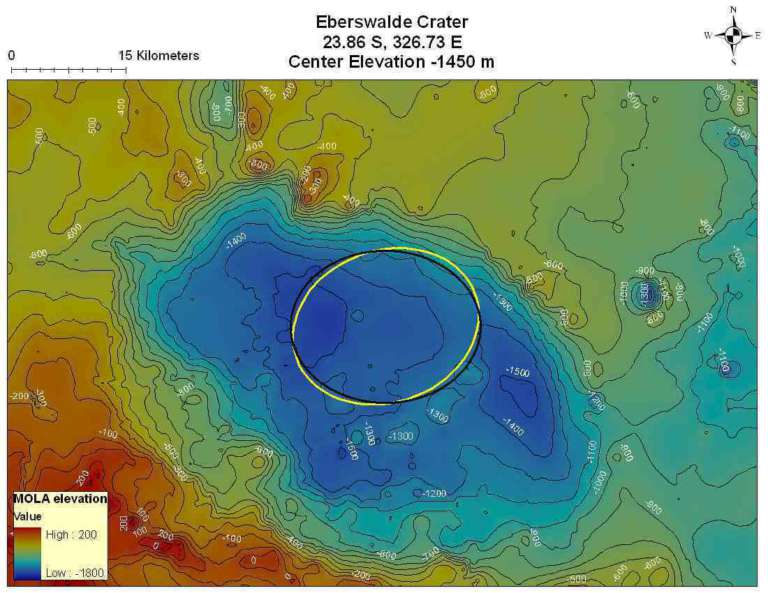Ryan Anderson • Sep 17, 2008
Potential MSL Site: Eberswalde
This article originally appeared on Ryan Anderson's "The Martian Chronicles" blog and is reposted here with permission.
The Eberswalde site is interesting because it is unarguably the best example of a delta on Mars. It is in a small crater that was partially obscured by the Holden impact and forms an enclosed basin with clear inflowing channels. (we know the source and the sink!) The hypothesis is that it was a long-lived lake with a large delta.
A delta environment is great because it is a location where you have a river bringing lots of sediment to a standing body of water, which results in rapid sedimentation. The faster sediments are lain down, the more likely they are to bury and preserve life (most of Earth's oil and natural gas are found in delta deposits for this reason).
The landing site in Eberswalde crater is east of the delta itself, on an area that includes small outcrops of what are thought to be sediments from the ancient lake. Within the ellipse there are also inverted river channels as well as some examples of "megabreccia": giant jumbles of rocks from large craters.
The nice thing about deltas is that the coarser particles tend to be deposited first, while the smaller grains (like clays) tend to stay in suspension and are deposited farther from the source. This means that the landing site would encounter the stuff rich in clays first, and also that we could use what we know about how deltas work to plan how to approach out study of Eberswalde.
Eberswalde satisfies all of the criteria that Roger Buick proposed on the first day of the workshop. (I have heard that he was horrified to hear that people were actually taking his criteria seriously enough to decide where to land on Mars) It has a diverse set of sedimentary rocks formed in what was likely a location with long-lived water, rapid formation of fine-grained rocks, minimal oxidation or acidic alteration, and little subsequent disturbance. It may have been "recently" exhumed by erosion, and has a well understood basic geology. How could you say no?!
The delta has plenty of clays apparent, but the megabreccia units also seemed to have clays of a specific type that indicates moderate to high-pH conditions which are more favorable to life. It was suggested that maybe the megabreccia could be ejecta from holden crater that ended up at the bottom of the Eberswalde lake and was altered there to form clays.
In the discussion of this site there were some concerns raised. For example, if this basin was once full of water but now isn't, why don't we see evaporite minerals? The answer given was that the water could have seeped or flowed away rather than evaporate. Also, there are lots of evaporites (sulfates) at the Opportunity landing site, but they can't be seen from orbit.
Someone else asked why the delta would be preserved but the lake floor deposits would be eroded. The answer given was that coarser grains in the delta "armored" it from erosion, but that made some people in the audience shake their heads.
Some of the comments were relevant to all of the sites, such as the question of whether clays are really a requirement for habitability. In the case of Eberswalde, the case was made that regardless of the mineralogy, there was fast sedimentation of fine grained stuff, so it would be good for preservation anyway.
One of the biggest problems with this site is that it could be considered a "one trick pony". That is, if we go there and confirm (or disprove?) that it is a delta, and then look for life, what else is there to do? Not a lot... and if there is no evidence of life preserved in the delta, there's not really anything else to look at that might give you a different answer.
I'm torn on this site, because it is really fascinating, but the one trick pony argument is a good point. You want to be able to test multiple different environments if possible. I think a lot of people like this site, so it may get carried, but I have also heard others say that Holden has some of the same stuff that Eberswalde does, plus other more diverse geology too.
The Time is Now.
As a Planetary Defender, you’re part of our mission to decrease the risk of Earth being hit by an asteroid or comet.
Donate Today

 Explore Worlds
Explore Worlds Find Life
Find Life Defend Earth
Defend Earth



